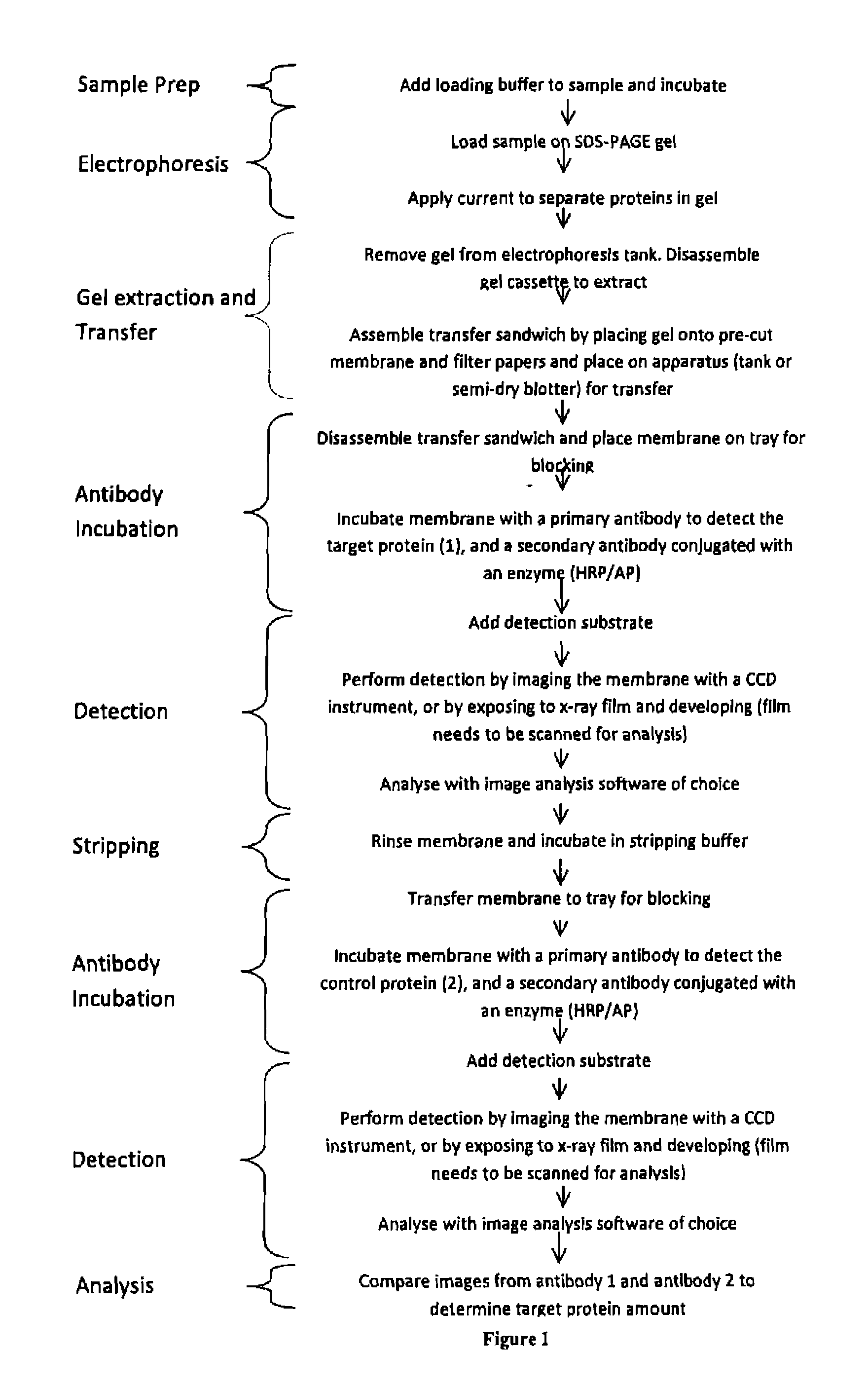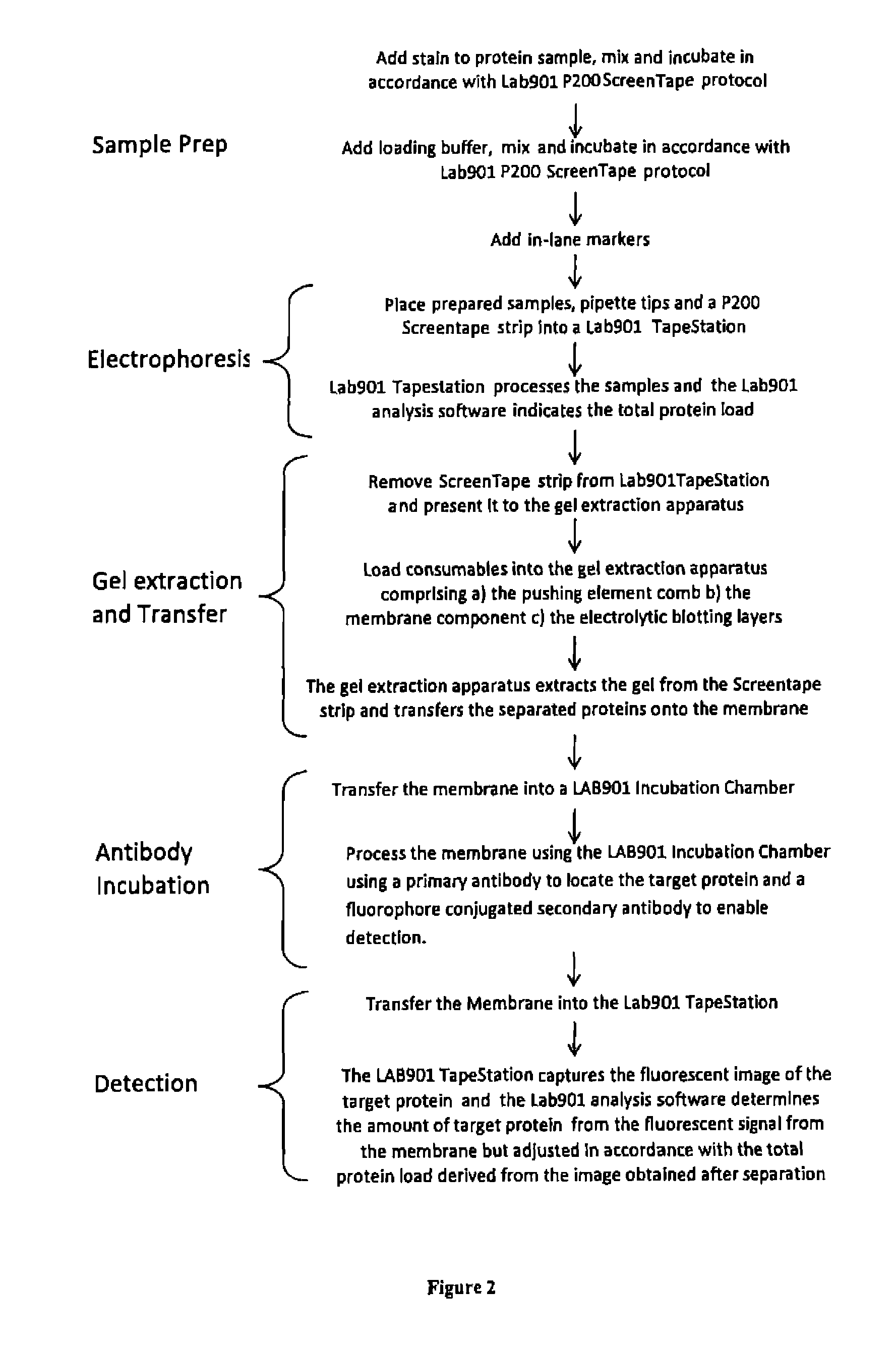Western blot analytical technique
a western blot and analytical technique technology, applied in the field of western blot analytical technique, can solve the problems of time-consuming and labor-intensive, the method requires labor-intensive staining and destaining steps, and the user cannot readily analyse the results of protein separation
- Summary
- Abstract
- Description
- Claims
- Application Information
AI Technical Summary
Benefits of technology
Problems solved by technology
Method used
Image
Examples
example 1
[0083]A sample comprising proteins was prepared as follows:[0084]a. Incubating a 20 μl protein sample with 20 μl fluorescent stain at 75° C. for 7 minutes; and[0085]b. Adding 40 μl of a loading buffer, mixing and incubating again at 75° C. for 5 minutes.
[0086]A control sample was also prepared as follows:[0087]a. Mixing a 20 μl protein sample with 10 μl of a reducing agent and 4×25 μl of Invitrogen's LDS buffer; and[0088]b. Incubating at 75° C. for 5 minutes.
[0089]Both samples were loaded onto a NuPAGE® electrophoresis gel and run according to the manufacturer's standard protocol to separate the proteins and then an image of the gel was captured using a UV transilluminator and a digital camera.
Transferring the Separated Samples onto Membranes
[0090]The gel comprising the separated proteins was separated into two halves and then one half was transferred onto a PVDF membrane and the other half was transferred onto a nitrocellulose membrane. The separated proteins wer...
example 2
[0102]A sample comprising proteins was prepared as follows:[0103]a. Incubating a 2 μl protein sample with 2 μl fluorescent stain at 75° C. for 7 minutes;[0104]b. Adding 4 μl of a loading buffer, mixing and incubating again at 75° C. for 5 minutes; and[0105]c. Adding 2 μl of in-lane marker.
[0106]The samples were loaded onto a Lab901 P200 ScreenTape® electrophoresis gel and run according to the manufacturer's standard protocol to separate the proteins. The used ScreenTape® was imaged using the Lab901 TapeStation® (see “P200” in FIG. 5a).
Transferring the Separated Samples onto Membranes
[0107]The used ScreenTape® comprising the separated proteins was recovered from the TapeStation®, its carrier layer was removed and two blades were used to cut away the top and bottom of the ScreenTape® exposing the top and bottom of the gel columns contained within 16 sub-containers. A comb comprising 16 gel pushing elements was used to push against the gel within each of the sub-cont...
example 3
[0119]A sample comprising proteins was prepared as follows:[0120]a. Incubating a 2 μl protein sample with 2 μl fluorescent stain at 75° C. for 7 minutes;[0121]b. Adding 4 μl of a loading buffer, mixing and incubating again at 75° C. for 5 minutes; and[0122]c. Adding 2 μl of in-lane marker.
[0123]The samples were loaded onto a Lab901 P200 ScreenTape® electrophoresis gel and run according to the manufacturer's standard protocol to separate the proteins. The used ScreenTape® was imaged using the Lab901 TapeStation® (see “P200” in FIG. 6a).
Transferring the Separated Samples onto Membranes
[0124]The used ScreenTape® comprising the separated proteins was recovered from the TapeStation®, its carrier layer was removed and two blades were used to cut away the top and bottom of the ScreenTape® exposing the top and bottom of the gel columns contained within 16 sub-containers. A comb comprising 16 gel pushing elements was used to push against the gel within each of the sub-cont...
PUM
| Property | Measurement | Unit |
|---|---|---|
| gel electrophoresis | aaaaa | aaaaa |
| molecular weight | aaaaa | aaaaa |
| intensity of fluorescence | aaaaa | aaaaa |
Abstract
Description
Claims
Application Information
 Login to View More
Login to View More - R&D
- Intellectual Property
- Life Sciences
- Materials
- Tech Scout
- Unparalleled Data Quality
- Higher Quality Content
- 60% Fewer Hallucinations
Browse by: Latest US Patents, China's latest patents, Technical Efficacy Thesaurus, Application Domain, Technology Topic, Popular Technical Reports.
© 2025 PatSnap. All rights reserved.Legal|Privacy policy|Modern Slavery Act Transparency Statement|Sitemap|About US| Contact US: help@patsnap.com



